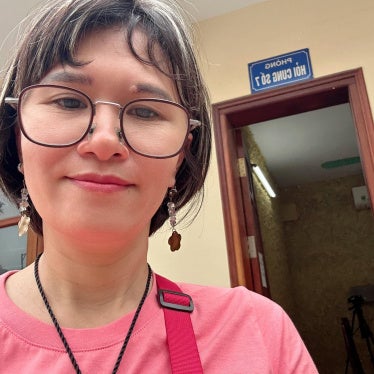(New York) - New satellite imagery and eyewitness accounts contradict Sri Lankan government claims that its armed forces are no longer using heavy weapons in the densely populated conflict area in northern Sri Lanka, Human Rights Watch said today.
Local sources have reported that more than 400 civilians have been killed and more than 1,000 wounded since May 9, 2009, as a result of artillery attacks on the thin coastal strip where fighting continues between government forces and the Liberation Tigers of Tamil Eelam (LTTE).
"Recent satellite photos and witness accounts show the brutal shelling of civilians in the conflict area goes on," said Brad Adams, Asia director at Human Rights Watch. "Neither the Sri Lankan army nor the Tamil Tigers appear to have any reluctance in using civilians as cannon fodder."
The American Association for the Advancement of Science (AAAS) today issued a preliminary analysis of commercial high-resolution satellite imagery of the conflict zone that shows craters from the use of heavy weapons and the removal of thousands of likely structures used by internally displaced persons (IDPs) between May 6 and May 10. The AAAS found that it was "certainly unlikely that the IDPs would have moved en masse, and so completely without a compelling reason." Tens of thousands of civilians remain trapped in the conflict area.
Witnesses described to Human Rights Watch harrowing days spent in shallow bunkers sheltering from artillery attacks and being prevented by the LTTE from escaping to government-controlled areas.
"K. Kanaga," a 35-year-old woman whose name is withheld for security reasons, said that around 7 p.m. on May 9, she and 15 others were hiding in a bunker that they had built under a tractor when a shell struck the tractor. "If it hadn't been for the tractor, we would have all been dead," she said. About eight to 10 shells struck the immediate area, which was populated with tents and improvised bunkers. Kanaga's 45-year-old cousin was staying in a tent nearby; she never reached the bunker and was killed in the attack. "Many other people were injured as well, but I don't know how many," Kanaga said. "I could hear their screams."
"R. Raman," 29, said that he and his family had been hiding in their bunker in Mullaivaikal - a dug-out trench without any cover - for several days. "We were being attacked from all sides," he said. "My wife and I only left the bunker to get food and water for our three children."
Early in the morning on May 9, a shell struck one of the tents closeby, killing Raman's 15-year-old nephew and wounding his nephew's older brother and sister. Raman believes that the shell came from Sri Lankan army positions and may have been targeting LTTE forces that were deployed in the jungle about 100 meters away. Several shells struck the tented area inhabited by displaced civilians.
Raman said he and his family were afraid to try to escape to government-controlled areas. When they and several hundred others had tried to leave the area in early April, LTTE fighters opened fire on them. "I saw them shoot at least 15 people," he said. "They just opened fire on the first row of people. I don't know whether they lived or died, however. We fell to the ground as soon as the firing started. When it stopped, we ran back as quickly as we could. There were children among the people who got shot as well." According to Raman, about half of the people managed to escape that day. The other half were forced to return.
According to doctors who spoke to Human Rights Watch, at around 8 a.m. on May 12 the makeshift hospital at Mullivaikkal was again shelled, as many wounded civilians were waiting for treatment. Nearly 1,000 patients were in the hospital at the time of the attack, including many wounded during attacks on May 9-10. A shell reportedly exploded in front of the admission ward during visiting hours, when many relatives came to visit patients, and doctors usually arrived for work. Doctors reported that the attack killed 49 people (26 immediately, others later succumbing to injuries); another 31 injured remain in the hospital. Among those killed was the administrative officer of Mullaitivu Regional Director of Health Services, who was arranging admission of a patient. A doctor said that the shelling came from the direction of Iraddaivaikal, where government forces are deployed. Human Rights Watch and other independent monitors have not been permitted access to the conflict area by the government, so cannot confirm these casualty figures.
The Mullivaikkal hospital, which had been newly relocated away from the front line, has been repeatedly hit by shells believed to have been fired by Sri Lankan army forces. Photographs of the hospital following the shelling today can be viewed at (slideshow link).
Human Rights Watch has repeatedly raised grave concerns about violations of international law by both parties to the conflict. The LTTE has violated the laws of war by using civilians as "human shields," by preventing civilians from fleeing the combat zone - including by use of lethal force - and by deliberately deploying their forces close to densely populated areas. The Sri Lankan armed forces have indiscriminately shelled densely populated areas, including hospitals, in violation of the laws of war.
Human Rights Watch reiterated its call to Sri Lanka's key donors - including the United States, the European Union, India, Japan, and China - to demand that the Sri Lankan government end its use of heavy weapons in densely populated areas, particularly near hospitals. Both the government and the LTTE should permit safe humanitarian corridors to allow civilians to flee the combat zone.
Human Rights Watch reiterated its call for the humanitarian situation in Sri Lanka to be urgently taken up by a formal meeting of the United Nations Security Council in New York and by a special session of the UN Human Rights Council in Geneva.







